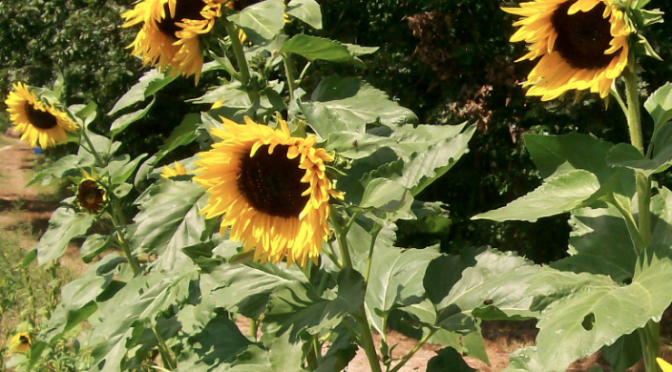If you grow sunflowers the garden looks a little extra magical this time of year! There’s just something special about these big flowers that follow the sun. Today, they are a popular crop for home gardeners and rank among the world’s most important oil crops but they’ve got a really long and interesting past too.
Domestication
Sunflowers were first cultivated by Native Americans. Some archeologists believe that they may have been grown in what’s now Arizona and New Mexico as early as 3000 BC. The seeds were an important food source and were used in a variety of ways including for grinding into flour, mixing with other vegetables, and squeezing for oil.
Sometimes sunflowers like the Hopi Dye Sunflower were also used to create dye for textiles, baskets, and body painting. They were also used medicinally and the stalks were sometimes utilized as building materials.
To Europe and Back
When Europeans came to America they quickly brought the sunflower back to Europe (probably around 1500). It was primarily grown as an ornamental until it became popular in Russia as an oil crop. During the early 1800s, it was commercially cultivated in Russia with more than 2 million acres planted each year and new varieties being bred.
Some of these new varieties like Mammoth made their way back to the United States to be featured in seed catalogs by 1880 and are still around today. They were most likely brought to the U.S. by Russian immigrants. In the early 1900s, sunflowers quickly gained popularity as oil and silage (animal feed) crops in the United States and Canada along with their ornamental use in the home garden.
Eating Sunflowers
As the title of this post suggests, sunflowers are a wonderful edible flower. It’s not just their seeds that are edible either. Very young plants as well as sunflower sprouts are excellent in salads and wraps. The flower petals, though they can be a bit bitter can also be used sparingly in salads to brighten things up or as natural decorations for cakes.
The leaves and stalk can also be eaten. When harvested young and peeled the stalk is a bit like celery. The leaves should be steamed or cooked like other greens before eating to destroy irritating hairs. Unopened flower buds can be cooked and used like artichokes.
Harvesting Sunflower Seeds
When to Harvest
Sunflowers are best harvested when they’ve fully matured. The plant’s foliage should be yellow and the back of the flower should be yellow or brown. The petals should have fallen off and the seeds should be plump and developed their dark or striped coloring. Harvesting too early when the plant is still alive and the seeds are light-colored will probably result in immature seed.
In order to get your sunflowers to mature this long, you may need to provide them with a bit of protection. They’re a favorite of birds, squirrels, and other small animals so you may need to wrap the flower heads in mesh or cover them with mesh bags to deter wildlife. Don’t use solid plastic bags. The material should be perforated or breathable or the flower head may rot.
Harvest
Cut the flower heads, leaving about 4-6 inches of stalk. Cover the flower heads with paper bags and hang them somewhere cool and dry for 1-2 weeks or until the seeds are fully dry and mature. They can also be laid out on screens if you have the space to set something up.
At this point, you can either separate the seeds or leave them on the head. Sunflowers can be hung outdoors for birds to enjoy through the winter or hung in your chicken coop for them to enjoy.
Rub the seeds off the flower head and lay flat to dry for an additional day. Then they can be stored in airtight containers out of direct sunlight. They’re ready to plant next year or roast for a tasty snack!

